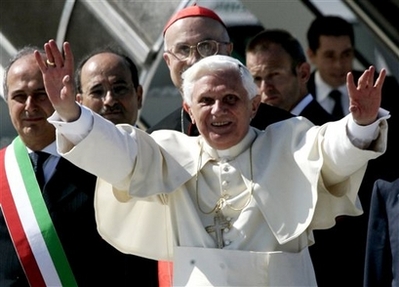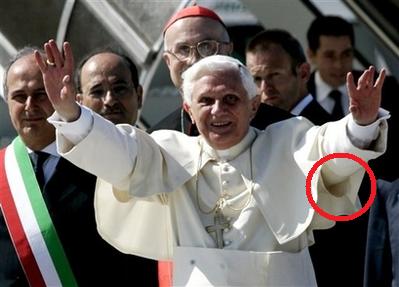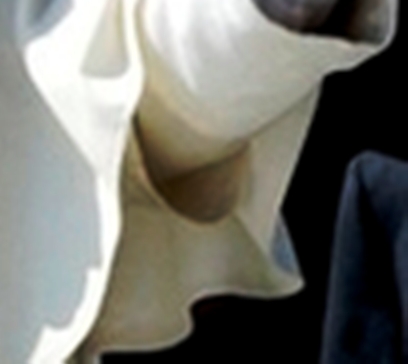I just noticed some interesting about His Holiness’s cassocks.
Notice something about his sleeves?

Not seeing anything interesting?

Here is a detail.

Maybe I simply missed it before, somewhere in the blogosphere, but it looks like the Holy Father has returned to the half-sleeves, over the tops of the sleeves of his cassock. I believe they were once suppressed, perhaps by Paul VI. At the least they went out of style a long time ago.
Good for Papa!
UPDATE: Sat 12 July 2338 UTC:
How about this additional observations from The Miscellany, probably for the younger crowd:



































Nice post. Paul suppressed them for all prelates, except for the Pope. Benedict, since day one as Pope in 2005 has had this false half-sleeve on this soutane.
I think he has always had these. I seem to recall noticing them shortly after he was elected and thinking JP II had not been wearing those.
For example, here is a photo of the Holy Father when he visited Brazil:
http://img.timeinc.net/time/photoessays/2007/pope_brazil/01.jpg
At the White House, more recently (I hadn’t noticed that he gave the peace sign!):
http://www2.pictures.gi.zimbio.com/President+Bush+Welcomes+Pope+Benedict+XVI+KGMu4I3DTg3l.jpg
I am sure with some digging much earlier photos can be found showing that he had the half-sleeves since the beginning.
All those layers must be rather warm in the Roman summer.
Mentioned in Gerald Warner’s “Cappaphobia.”
Pope Benedict house cassock (his soutane or cassock with shoulder cape) also includes the upper half-sleeves discontinued for all other clerics by the authority of Paul VI’s motu proprio “Pontificalis Domus” of 1968.
This is on a post of Sep. 16th 2006 here: http://sbcouthouse.blogspot.com/2006/09/motu-proprio-pontificalis-domus.html
I am just noticing this now.
I recall reading that the half-sleeves on the papal simar were never discontinued.
The abolition applied only to other clerics’ simars. I think I read this in James Charles Noonan’s “The Church Visible,” which was published during the last pontificate.
As Tobias just pointed out, it’s called a “simar,” and it’s a different garment than the cassock; it’s not a ‘cassock with a cape.’
“discontinued for all other clerics by the authority of Paul VI’s motu proprio “Pontificalis Domus””
But in England? It was the formal soutane for English clergy from the restoration of the heirarchy.
It wasn’t unusual to see English bishops dressed in habito piano in this style until a decade ago.
Mr. Whitehead, I think that what was discontinued was the half-sleeve, not the simar
as such. Prelates still wear the simar with fascia.
Sorry – but Benedetto has had these all during his pontificate and you just
needed to have had a closer look each time he raised his arms. Nothing new at all and besides it probably acts as a good ventilation system in the hot weather. So good tailoring. Anyway, does it really matter how the sleeves/half sleeves are done? I really don’t think its a big issue. And whilst on the subject of the pontiff’s clothing, I don’t know why the media
is so focused on his red shoes. These have been around for pontifical ages and the fuss over BXVI’s red shoes just shows how the media focus on the small matters and have never looked at a pope’s feet wear prior to 2005. Amazing when so many children die very day without coverings on their feet.
Well, it may not even be a Benedictine “re-innovation” — we’ll have to find photos of
John Paul II waving (which shouldn’t be difficult) in order to see whether he had the
half-sleeves.
Somehow the thought of “surpressing sleeves” at the time when everything else was going to heck in a handbasket made me smile.
Yes, Benedict had these all along. He also retains the small hood on the mozzetta, which was also formally suppressed. Pope John Paul II not only wore the proper soutane (thanks to those who pointed out the difference! So few understand they are completely different animals) for a while, but he also wore the white watered silk cassock!!!!! There is a picture of him walking somewhere in it with one of the prothonotaries apostolic in tow. I think the photograph is published in that wretchedly errant book, “The Church Visible”
My impression of the Gammarelli family is they simply revert to the traditional styles unless specifically asked to “modernize”!
Okay, I’ll say it: why should I feel one way or the other about this?
May be we are going to see the “fimbria” also called “falda papale” in the near future, who knows?
I would love to see Paul VI’s motu proprio “Pontificalis Domus” completely reversed!
Fr. Fox: Okay, I’ll say it: why should I feel one way or the other about this?
LOL! I wasn’t quite thinking that, but something similar. Perhaps I’m missing the obvious.
Look, all of these things had reasons for being at one time or another. Take the maniple during Mass for example. First to wipe sweat, but then the maniple took on a greater, deeper meaning.
Granted, we are talking about what the pope wears outside of the Mass, but my interest is heightened here and begs the question:
What is a half-sleeve, it’s purpose, and why was it suppressed? Perhaps that is a little like asking why nun’s habits were suppressed.
Is it penitential (because it is already kind of hot without added clothing)? Or, was it as simple as being in style at a given time, such as the fedora which was worn by practically all men in the west for a certain number of decades, then faded?
I kind of like these posts as they are just a break from the more serious stuff.
Speaking of fashion, am I the only one who is hoping we will see a resurgence of hair-shirts and flagellant vestments as well? Yeah? Oh, then never mind.
One thing struck me after seeing all those photos: why is the Pope smiling so much? I mean, he’s a traddie! Traddies don’t smile, have fun or enjoy life! They’re supposed to be dour, solemn and reactionary ALL THE TIME. Everyone knows only liberals are the happy ones.
*on a serious note, I am happy to see our beloved Pope (may God bless him and grant him 100 years) looking like he is enjoying life. It would be impossible for any of us to understand the daily struggles he is going through with the shape of the church he inherrited. I think a lesser amn would be very bitter (including yours truly).
Alessandro, I sincerely doubt we’re going to see the falda ever again. Mainly because it was discontinued by Bl. John XXIII, not Paul VI.
I still see pics of bishops wearing simars with half sleeves. The half sleeves were decorative, they also had five buttons on them (much like many cassock cuffs) which symbolized the five wounds of Christ.
Simars have integral shoulder capes and have/had half sleeves. There was a time when simars were sold as “doctor’s cassocks” “house cassocks” etc. and improperly worn by priests probably because the privilege to wear a shoulder cape (detachable) with the cassock was granted to priests in various areas in the last century. Thus, while they look similar, a cassock worn with a shoulder cape and a simar are two different things.
As to confort, you’d be suprised how comfortable cassocks are. I was wearing one (black and wool) in 90+ degree heat with very high humidity and was just fine. White would probably be even better.
Early photos of JPII have the half-sleeves, until he stopped as he felt the heat dreadfully, being a northerner, hence his ultra-thin soutanes and minimal use of hot outer clothes. He still wore them, and also the red galero, in Mexico, of which I have photos.
Your ‘Diane @ Te Deum’ correspondent seems to think priests remove their soutanes under their vestments! No, my dear, they do not!!!
The English clergy wore the papal soutane in black, with half-sleeves. Someone here will tell us, as I forget, which 19th century pope concede this privilege. Possibly Mr Whitehead?
Extra Stuff on Half-Sleeves
“I would love to see Paul VI’s motu proprio “Pontificalis Domus” completely reversed!”
Amen brother!
At times, especially on his vacations, he has worn a simple white cassock with no half-sleeves and no shoulder cape.
Re J Basil Damukaitis:
The soutane and cassock are the same thing; it is the simar that is different.
It is incorrect to call the Pope’s customary garment a “cassock” and “soutane.” Popes
do not wear cassocks/soutanes. They wear simars. If it has a should-cape attached to it, you’re probably dealing with a simar. Yes, I know that the simar is basically a cassock plus a shoulder-cape, but there are different words for these garments for a reason. For the Pope, the
simar is white. For Cardinals, it is usually black with scarlet piping, and for
bishops it has amaranth piping. I suppose that in the tropics, there is an exception
that permits white with the appropriate color of piping. http://en.wikipedia.org/wiki/Simar VS. http://en.wikipedia.org/wiki/Cassock
In the Commonwealth, apparently priests had a right to a shoulder cape on their
cassocks/soutanes, as Dominic1962 above notes.
Okay, so now Fr. Jay Toborowsky has pointed out that sometimes the Pope wears a regular
white cassock instead of a simar. Is this traditional or an innovation? I thought
that the Pope wore a simar even when prelates generally wore a choir cassock. But that
would be rather difficult, I would think, if the Pope were to put an amice or alb over
a shoulder-cape. Wouldn’t that be rather cumbersome, with the sleeves of the alb and
dalmatic positioned over a should-cape?
Father Z, I think what is more interesting is that the Holy Father has made use of a simple white cassock during his vacations which some readers above had mentioned. According to Noonan (it’s a very good read!), “the Holy Father does not make use of the cassock. By tradition, he dons only the white simar on all occasions,” (291). So, in fact, this present Holy Father is being a little edgy by wearing a simple white cassock! I find THAT a very interesting tidbit.
LOVE the Super Half-sleeves of Valour…
love the fact that it raises his
armour class and can be used to defend against dragon fire!
Very Benedictine. Very cool.
Say, Hung Doan, apparently you have Noonan’s book at hand. Would you please check out
the section on the simar to see if the half-sleeves were ever suppressed on the papal
simar? I’d like to lay this issue to rest.
Why would such seemingly insignificant things need to be suppressed by Paul VI?
Actually, I don’t see how we can fault Pope Paul VI on this. Virtually no one ever sees the half-sleeves,
which are hidden by the simar’s shoulder-cape. I don’t know what their practical
function would be, and their symbolic value seems to come as close to nil as one can
get. Apparently they had five buttons in honor of the Five Wounds. But that is the
symbolism of a number of buttons on what is likely an irrelevant decorative piece of
clothing. Probably half-sleeves increase the cost of the simar to some extent —
more cloth, more stitching, etc. And who among us knows what if feels like to wear
them? So when Pope Paul VI was writing a document on cutting corners he cut out something
practically no one could miss. Actually, suppressing “such seemingly insignificant
things” (Garrett’s words, not mine) is a good policy, as opposed to maintaining such “seemingly insignificant things.” In order to argue the contrary, you would have to find a significance in the half-sleeves. Half-sleeves in, half-sleeves out, long live the usually invisible half-sleeve?
Tobias:
Thank you for the correction, I was thinking simar and wrote soutane. Please all… don’t use Noonan as a reference for anything!! He is riddled with errors. As far as checking what is suppressed, go to the the appendicies of the “Caeremoniale Episcoporum”. But yes, the half sleeve was suppressed. Remember, because the pope is the ‘supreme legislator’ he can do whatever he wants outside issues of faith and morals and it is ipso facto, correct’.
Important point to remember: The suppressions and new rules on dress DO apply to the Old Mass. Just because a prelate attends the extraordinary form doesn’t mean he can assume the vesture pre-1969. That is a time warp mentality. Current legislations still apply, mutatis mutandis.
JBD: what’s a good overall reference to vesture in in the Church Post Vatican II? Noonan seems like a good start, it contains a good summation of the ceremonial life of the church, but now I’m interested in more thorough resources.
Tobias: yes, the oversleeves for all but the Supreme Pontiff were suppressed according to half a dozen sources, Noonan included =)
Yes, thanks Hung Doan — the only thing in dispute was whether the suppression applied
to the Pope. As it did not, Benedict’s use of the half-sleeves is not actually a
“re-innovation,” but merely a continuance of papal custom. Of course, it is so rare
to actually see the half-sleeves that one could easily mistake them for a re-introduction.
JBD: “Important point to remember: The suppressions and new rules on dress DO apply to the Old Mass. Just because a prelate attends the extraordinary form doesn’t mean he can assume the vesture pre-1969.”
I would argue the opposite. We can start with the maniple and proceed to the biretta during Mass to refute your argument.
I wish people would stop trying to pretend one can apply 2008 rules to the 1962 missal. It just doesn’t work. We’ve got a year to work with — 1962. That’s the guide. Trying to shove a brand new fuel pump in a 62 Cadillac is going to present you with a host of challenges.